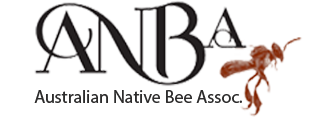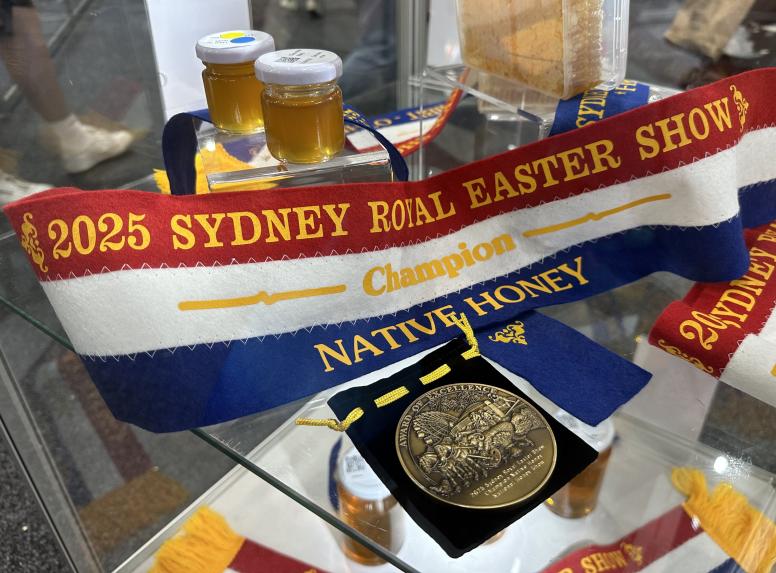By Sam Higgins, Sydney Branch Vice -Chair
For the past four years, I’ve had the privilege of serving as the judge for the Australian Native Bee Association’s (ANBA) Native Bee Honey Classes at the prestigious Sydney Royal Easter Show’s National Honey Competition.
This role has not only allowed me to witness the evolution of native bee honey production but also to appreciate the incredible variety and richness of the honey harvested by our talented members. The journey of honey judging has always been one of meticulous attention to detail. From color and clarity to taste and aroma, each jar tells the story of the bees, the landscape, and the beekeeper. But this year marked a particularly significant moment in the history of the competition one that stands as a testament to our commitment to showcasing the unique qualities of native bee honey. For the first time, we introduced the Champion Native Honey award.
This bold move aimed to elevate the profile of native honey production within the broader honey community.
The introduction of a champion was not just about creating a new title; it was about recognizing the exceptional
quality and hard work of our native beekeepers. It was about giving them the stage they deserve, and it has already had a profound impact on the perception of native bee honey, both within our community and beyond.
Understanding the Judging Criteria
For those new to the competition, it’s important to understand what judges look for when assessing native
honey. The judging criteria have been evolving over the past six years, beginning with Tobias Smith’s early work
to adapt the traditional European honey judging criteria for native bee honey. The criteria have since been refined
to better reflect the unique characteristics of native bee honey.
These key factors contribute to the overall score:
Flavour (30 points): This is assessed by the initial taste, secondary taste, and any lingering mouthfeel. A wellbalanced honey will offer complexity and depth.
Aroma (25 points): The scent is evaluated both immediately upon opening the jar and shortly thereafter. Aromas of mould or fermentation are considered undesirable.
Clarity (25 points): Judges look for honey that is free of contamination from particles like pollen, dirt, tree bark,
or propolis.
Density (15 points): This refers to the moisture content of the honey, which is measured using a refractometer where possible; otherwise, it is based on visual inspection of the honey’s viscosity.
Brightness (5 points): In the case of our native bee honey this refers to the absence of any visible bubbles before the jar is opened. Bubbles can be an indication of fermentation or contamination. As such brightness correlates with the stability and purity of the honey. In this competition, we use a reverse scoring or decremental scoring method. This means that all entries are initially assumed to have achieved the maximum possible score, and deductions are made based on how the entry deviates from the ideal. The focus is on penalizing flaws or shortcomings rather than rewarding perfection.
Each entry is thus judged on a total of 100 points, with the final score reflecting the degree to which the honey meets the judging criteria. It’s important to note that this method makes it difficult to compare scores from year to year, as the field of competition can vary each time. Rather than focusing on absolute scores, the goal is to encourage entrants by highlighting their performance, relative to the field in which they compete. Each year presents a new opportunity to showcase the unique qualities of native honey, and the scoring method fosters continuous improvement by identifying areas for growth while celebrating the progress made within each category.

Reflecting on This Year’s Judging: A Look at Native Bee Honey Excellence
As a judge, I’ve always been impressed by the passion and dedication that goes into each jar of native honey.
This year’s entries were no exception, though they did present a mixed bag of results.
For the past two years, in addition to the great support from past Stewards such as Patrice Newell and Dani Lloyd -Prichard, I’ve had the pleasure of being aided by Adam Hutchinson, Chair of the Sydney Branch, as my Associate Judge. This year, we were joined by Megan Halcroft, President of the ANBA, as our Steward. This marked the first time our honeys were judged by an entirely ANBA team, which added a special layer of connection and insight to the process.
Working together with such experienced and passionate individuals further enriched the judging experience, and their knowledge of native bees and honey shone through in every discussion. In the Liquid Honey – Native Class 0043, produced by Tetragonula carbonaria, we saw extremely wellpresented entries, with high scores for clarity and brightness. However, the complex aromas that have made T. carbonaria honey so distinctive in the past were less pronounced this year.
Still, there were examples of the classic tangy-sweet, citrus flavours that are a hallmark of this species. One ongoing challenge was that some jars were overfilled, which hampered the buildup of aroma. Additionally, a few entries exhibited slight surface mold, highlighting the need for proper food handling and hygiene practices, such as ensuring clean, aseptic equipment and dry jars and lids. This year’s winners were Sarah Tune from Stingless Native Bees and Cassandra Goodworth, both of whom demonstrated exceptional honey production, earning top honors in the category.
In the Liquid Honey – Native Class 0044, produced by Tetragonula hockingsi, the entries were fewer this year, and the classic taste and aroma of T. hockingsi were not as evident as in previous years. Unfavorable weather conditions in northern NSW and Queensland likely contributed to a more challenging season for meliponists. Nevertheless, entries from Stingless Native Bees and Sian Swales still showcased the potential of this unique honey, even in a tough year.
Finally, in the newly introduced Champion Native Honey category, Sarah Tune from Stingless Native Bees took home the RAS of NSW Award of Excellence Medallion, marking a proud moment for Sarah, the ANBA and the entire native honey community. Sarah’s entry exemplified the clarity, brightness, and complex aromas we strive to celebrate in the competition.
I’m excited about what the future holds for native bee honey as we continue to advance competitions, with an inaugural event as part of the Rockhampton Show (Rocky Show) in June and our third year at the Brisbane Exhibition (Ekka) in August.
With the introduction of the Champion Native Honey award here in Sydney, we’ve set a new standard for excellence, and I believe this will inspire more beekeepers to focus on the unique and distinctive qualities of native honey. Our mission remains clear: to celebrate and promote the importance of native bees, not just for their role in pollination, but for the incredible honey they produce. I look forward to seeing even more entries in the coming years and continuing to share the story of native bee honey with our community and the wider world.

